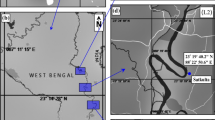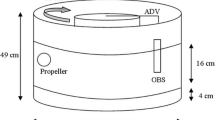Abstract
Evolution of the riverbank morphology due to the removal and collapse of bank sediment results in substantial loss of fertile land and human property. At the lower stretch of a perennial river, clay–sand mixed bank sediments are predominant. Existing literature reveals that large shear stresses are generated due to the interaction between the hydrodynamic forces and bank roughness. This may lead to the dislodgement of the sediment particles from the bank surface. The generation of shear stress of a turbulent flow depends on the scales of turbulent fluctuations and the clay–sand network structures (size, shape, and arrangement of clay and sand particles). However, information on the modulation of turbulent flow structures due to the variation of clay–sand network structures of the bank sediment remains unrevealed. In the present experimental investigation, an attempt is undertaken to study the effect of sediment surface roughness and the associated turbulent scales of the interacting flow. This is achieved by fabricating artificial banks of five different proportions of clay in the clay–sand mixture in a laboratory flume. Scanning electron microscope (SEM) and 3D profilometer measured the surface roughness parameters of clay–sand network structures for different clay proportions. Information on near bank turbulence characteristics was quantified using a 16 MHz acoustic Doppler velocimeter (ADV). Results from the present study show that the surface roughness of bank sediment decreases with increasing clay fraction in the clay–sand network structure of the bank sediment, which also lowers the associated turbulent velocity fluctuations or eddy scales of the flow. Furthermore, small-scale turbulent fluctuations decrease the sediment entrainment rate from the bank face.








Similar content being viewed by others
References
Alvarez-Hernandez EM(1990) The influence of cohesion on sediment movement in channels of circular cross-section. Ph.D. Thesis, University of New Castle upon Tyne, New Castle upon Tyne
ASCE Task Committee on Hydraulics, Bank Mechanics, and Modeling of River Width Adjustment (1998) River width adjustment: I. Processes and mechanisms. J Hydraul Eng 124:881–902
Bandyopadhyay PR (1987) Rough-wall turbulent boundary layers in the transition regime. J Fluid Mech 180:231
Barman K, Debnath K, Mazumder BS (2016) Turbulence between two inline hemispherical obstacles under wave–current interactions. Adv Water Resour 88:32–52
Barman K, Roy S, Das VK, Debnath K (2019) Effect of clay fraction on turbulence characteristics of flow near an eroded bank. J Hydrol 571:87–102
Best J (2005) The fluid dynamics of river dunes: a review and some future research directions. J Geophys Res Earth Surf 110(F4):F04S02. https://doi.org/10.1029/2004JF000218
Bhaganagar K, Kim J, Coleman G (2004) Effect of roughness on wall-bounded turbulence. Flow Turbul Combust 72:463–492
Bisschop F(1993) Erosieproeven op zand met variatie in doorlatendheid. Combinatie Speurwerk Baggertechniek BAGT510 No. J714, WL/Delft Hydraulics, Delft (in Dutch)
Black KS, Tolhurst T, Paterson DM, Hagerthey SE (2002) Working with natural cohesive sediments. J Hydraul Eng 1281:2–8
Blanckaert K, Duarte A, Chen Q, Schleiss AJ (2012) Flow processes near smooth and rough (concave) outer banks in curved open channels. J Geophys Res Earth Surf 117(F4):F04020. https://doi.org/10.1029/2012JF002414
Brownlie WR (1983) Flow depth in sand-bed channels. J Hydraul Eng 109(7):959–990
Camporeale C, Perucca E, Ridolfi L, Gurnell AM (2013) Modeling the interactions between river morphodynamics and riparian vegetation. Rev Geophys 51(3):379–414
Clark LA, Wynn TM (2007) Methods for determining streambank critical shear stress and soil erodibility: implications for erosion rate predictions. Trans ASABE 50(1):95–106
Darcy H (1857) Recherches expérimentales relatives au mouvement de l’eau dans les tuyaux, vol 1. Mallet-Bachelier, Washington
Das VK, Roy S, Barman K, Debnath K, Chaudhuri S, Mazumder BS (2019) Investigations on undercutting processes of cohesive river bank. Eng Geol 252:110–124
Debnath K, Nikora V, Elliott A (2007) Stream bank erosion: in situ flume tests. J Irrig Drain Eng 133(3):256–264
Engel FL, Rhoads BL (2017) Velocity profiles and the structure of turbulence at the outer bank of a compound meander bend. Geomorphology 295:191–201
Flack KA, Schultz MP, Shapiro TA (2005) Experimental support for Townsend’s Reynolds number similarity hypothesis on rough walls. Phys Fluids 17:035102
Goring DG, Nikora VI (2002) Despiking acoustic Doppler velocimeter data. J Hydraul Eng 128(1):117–126
Grissinger EH, Asmussen LE, Espey WH (1963) Discussion of channel stability in undisturbed cohesive soils by EM Flaxman. J Hydraul Div ASCE 89:259–264
Hackney C, Best J, Leyland J, Darby SE, Parsons D, Aalto R, Nicholas A (2015) Modulation of outer bank erosion by slump blocks: disentangling the protective and destructive role of failed material on the three-dimensional flow structure. Geophys Res Lett 42(24):10–663
Hagen GHL (1854) Über den einfluss der temperatur auf die bewegung des wassers in röhren—Druckerei der Königl. Akademie der wissenschaften, Vienna
Hardy RJ, Best JL, Lane SN, Carbonneau PE (2009) Coherent flow structures in a depth-limited flow over a gravel surface: the role of near-bed turbulence and influence of Reynolds number. J Geophys Res 114:1003
Houwing EJ(2000) Sediment dynamics in the pioneer zone in the land reclamation area of the Wadden Sea, Groningen, The Netherlands. Ph.D. Thesis, University of Utrecht, Utrecht
Houwing EJ, Van Rijn LC (1998) In situ erosion flume (ISEF): determination of bed-shear stress and erosion of a kaolinite bed. J Sea Res 39(3–4):243–253
Jiménez J (2004) Turbulent flows over rough walls. Annu Rev Fluid Mech 36:173–196
Kamphuis JW, Hall KR (1983) Cohesive material erosion by unidirectional current. J Hydraul Eng 109(1):49–61
Keirsbulck L, Labraga L, Mazouz A, Tournier C (2002) Surface roughness effects on turbulent boundary layer structures. J Fluids Eng 124:127–135
Kothyari UC, Jain RK (2008) Influence of cohesion on incipient motion condition of sediment mixtures. Water Resour Res 44(4):1–15
Krogstad P-A, Antonia RA (1994) Structure of turbulent boundary layers on smooth and rough walls. J Fluid Mech 277:1–21
Krogstad P-A, Antonia RA, Browne LWB (1992) Comparison between rough- and smooth-wall turbulent boundary layers. J Fluid Mech 245:599–617
Leonardi S, Orlandi P, Smalley RJ, Djenidi L, Antonia RA (2003) Direct numerical simulations of turbulent channel flow with transverse square bars on one wall. J Fluid Mech 491:229
Ligrani PM, Moffat RJ (1986) Structure of transitionally rough and fully rough turbulent boundary layers. J Fluid Mech 162:69–98
Liu Z (1998) Sediment transport. Aalborg University, Aalborg, pp 54–56
Mazurek KA, Rajaratnam N, Sego DC (2001) Scour of cohesive soil by submerged circular turbulent impinging jets. J Hydraul Eng 127:598–606
McAnally WH, Mehta AJ (2000) Aggregation rate of fine sediments. J Hydraul Eng 126:883–892
Mirtskhoulava TE (1991) Scouring by flowing water of cohesive and noncohesive beds. J Hydraul Res 29(3):341–354
Mitchener H, Torfs H (1996) Erosion of mud/sand mixtures. Coast Eng 29:1–25
Nakagawa H, Nezu I (1977) Prediction of the contributions to the Reynolds stress from bursting events in open-channel flows. J Fluid Mech 80:99–128
Nezu I, Nakagawa H (1993) Turbulence in open-channel flows. IAHR monograph series. AA Balkema, Rotterdam
Nikora VI (2008) Hydrodynamics of gravel-bed rivers: scale issues. In: Habersack H, Habersack H, Rinaldi M (eds) Gravel-bed rivers VI: from process understanding to river restoration. Elsevier, Boston, pp 61–81
Nikuradse J (1933) Strömungsgesetze in rauhen Rohren. Forsch Arb Ing Wes, Heft, p 361
Panagiotopoulos I, Voulgaris G, Collins MB (1997) The influence of clay on the threshold of movement of fine sandy beds. J Coast Eng 32(19):43
Perry AE, Chong MS (1982) On the mechanism of wall turbulence. J Fluid Mech 119:173
Perry AE, Joubert PN (1963) Rough-wall turbulent boundary layers in adverse pressure gradients. J Fluid Mech 17:193
Raudkivi AJ (1990) Loose boundary hydraulics, chapter 9, 3rd edn. Pergamon, New York, pp 237–296
Raupach MR, Antonia RA, Rajagopalan S (1991) Rough-wall turbulent boundary layers. Appl Mech Rev 44:1–25
Rinne H (2010) Location-scale distributions- linear estimation and probability plotting using MATLAB. Justus-Liebig-Universität Giessen, Giessen
Römkens MJ, Helming K, Prasad SN (2002) Soil erosion under different rainfall intensities, surface roughness, and soil water regimes. CATENA 46(2–3):103–123
Roy S, Debnath K, Mazumder BS (2017) Distribution of eddy scales for wave current combined flow. Appl Ocean Res 63:170–183
Roy S, Debnath K, Mazumder BS (2018) Distribution of turbulent eddies behind a monopile for vortex lock-on condition due to wave current combined flow. Coast Eng 131:70–87
Roy S, Das VK, Debnath K (2019) Characteristics of intermittent turbulent structures for river bank undercut depth increment. CATENA 172:356–368
Schlichting H (1960) Boundary layer theory. Trans J, Kestin
Schultz MP, Flack KA (2003) Turbulent boundary layers over surfaces smoothed by sanding. J Fluids Eng 125:863
Schultz MP, Flack KA (2007) The rough-wall turbulent boundary layer from the hydraulically smooth to the fully rough regime. J Fluid Mech 580:381–405
Schumm SA (1963) Sinuosity of alluvial rivers on the Great Plains. Geol Soc Am Bull 74(9):1089–1100
Shockling MA, Allen JJ, Smits AJ (2006) Roughness effects in turbulent pipe flow. J Fluid Mech 564:267–285
Shojaeizadeh A, Safaei MR, Alrashed AA, Ghodsian M, Geza M, Abbassi MA (2018) Bed roughness effects on characteristics of turbulent confined wall jets. Measurement 122:325–338
Singh A, Georgiou EF, Agel FP, Wilcock PR (2012) Coupled dynamics of the co evolution of gravel bed topography, flow turbulence and sediment transport in an experimental channel. J Geophys Res 117:F04016
Soulsby RL (1994) Manual of marine sands. HR Wallingford Report SR351
Sukhodolov A, Thiele M, Bungartz H (1998) Turbulence structure in a river reach with sand bed. Water Resour Res 34:1317–1334
Tennekes H, Lumley JL (1972) A first course in turbulence. MIT press, Cambridge
Thorne CR (1982) Processes and mechanisms of river bank erosion. In: Hey RD, Bathurst JC, Thorne CR (eds) Gravel-bed rivers: fluvial processes, engineering and management. Wiley, Chichester, pp 227–271
Townsend AA (1976) The structure of turbulent shear flow, 2nd edn. Cambridge University Press, Cambridge
van Ledden M, Van Kesteren WGM, Winterwerp JC (2004) A conceptual framework for erosion behaviour of sand-mud mixtures. Cont Shelf Res 241:1–11
Williamson H, Ockenden M (1993) Laboratory and field investigations of mud and sand mixtures. Adv HydroSci Eng 1:622–629
Yu MH, Wei HY, Wu SB (2015) Experimental study on the bank erosion and interaction with near bank bed evolution due to fluvial hydraulic force. Int J Sediment Res 30(1):81–89
Acknowledgements
The authors would like to acknowledge the Science & Engineering Research Board, Department of Science and Technology, Government of India for the financial support for this research (Contact no. EMR/2015/000266). Authors are also thankful to Dr. Anupam Ghosh, Assistant Professor, Department of Geological Sciences, Jadavpur University for the kind permission for using the SEM at SEM, EDS laboratory. Authors would also like to thank Mr. Santanu Sardar, Ph.D. Research Scholar, Department of Mechanical Engineering, Indian Institute of Engineering and Science, Shibpur, Howrah, India for helping us with the 3D profilometer.
Author information
Authors and Affiliations
Corresponding author
Additional information
Publisher's Note
Springer Nature remains neutral with regard to jurisdictional claims in published maps and institutional affiliations.
Rights and permissions
About this article
Cite this article
Das, V.K., Roy, S., Barman, K. et al. Study of clay–sand network structures and its effect on river bank erosion: an experimental approach . Environ Earth Sci 78, 591 (2019). https://doi.org/10.1007/s12665-019-8613-5
Received:
Accepted:
Published:
DOI: https://doi.org/10.1007/s12665-019-8613-5





